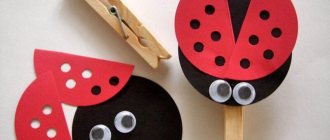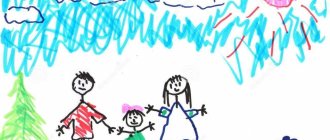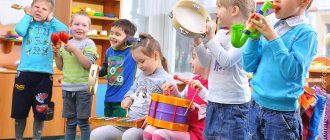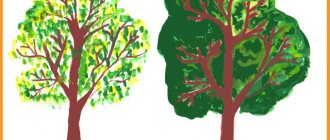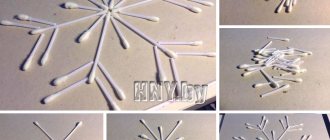MAGAZINE Preschooler.RF
Project for parents and children of primary preschool age “Weekend Walks”Topic: “Yellow Brick Road”
Type of project: educational - gaming, recreational
Project duration: short-term
Author: Ivannikova Marina Dmitrievna
Participants: children, parents, teachers.
Age of children: younger group.
Goal: to teach parents how to properly spend family leisure time outdoors on weekends.
Project objectives:
- integrate various types of joint activities of children and parents during the preparation and conduct of a day off in the family
- create conditions during a walk for the environmental and physical education of preschool children
- organize family leisure on weekends
- create a photo album: “Weekend walks”
Parent-oriented teacher tasks:
- advise parents on practical skills for preserving and promoting children’s health
- to develop parents' interest in spending time together with their children on weekends
- equip parents with basic theoretical knowledge and practical skills in the field of health and physical activity
- increase the competence of parents in the field of health care: provide information about the importance of an active child’s walk outside, options for carrying it out, drinking regime during a walk, proper dressing of children according to the seasons
- introduce parents to active and sedentary games with children of primary preschool age
Child-oriented teacher tasks:
- children's accumulation of impressions about bright seasonal changes in nature
- replenishing children's active vocabulary with the names of flowers and trees
- reinforcement of safety regulations and rules of safe behavior on the playground
- nurturing emotional responsiveness and respect for nature.
Hypothesis
“If you correctly form a child’s initial ideas about the world around him, the culture of communication, the beauty of life through joint walks with his parents, then he can raise an intellectually developed, creative personality.”.
Relevance:
A day off is an opportunity for longer communication between parents and children. The baby learns a lot of new things while walking with mom and dad around the village and in nature. Even in the yard, a walk together brings joy to the child: riding a bicycle, playing with a ball, outdoor games, and in winter - skating and sledding. Playing together helps children develop the skills they need to be prepared to face a challenging world in the future.
After all, a well-spent weekend not only contributes to the unity of all family members, but also helps the child understand how important he is to his parents, forms his connections with the outside world, and simply creates a great mood and gives a charge of vivacity for the entire working week, both for adults and and children.
We must not forget that walking improves our mood and our well-being. Our brain is saturated with oxygen. The more walks, the less disruption in our body. Thanks to being in the fresh air, anyone's sleep will be more sound and enjoyable. And this is very important for a growing organism.
For adults, a family walk is a unique opportunity not only to improve the health of children, but also to enrich the child with new knowledge, to show experiments, the material for which is provided by nature itself, to develop attention, memory and respect for nature.
Project implementation:
- Preparatory stage
- Main stage
- The final stage
Preparatory stage:
- Selecting a project topic, setting goals and objectives
- Studying literature on the project topic
- Studying Internet resources on the project topic
- Studying the available conditions for walking
- Questioning of parents (questioning to obtain information about how children spend their days off, what they do, whether parents know what games their children play. Do parents themselves know outdoor games)
- Informing parents about the idea of the project and jointly developing a plan, forms and methods for implementing the walk
- Selection of advisory material for parents
- Conversations with children about the weekend
- A selection of outdoor games for children and their parents
- Selection and creation of presentations: “Traffic rules for kids” , “Trees and flowers of our region” (focusing on the age of children), “Pencil’s Travels” (the author’s interactive game on life safety for knowledge of behavior on the street and the playground), “My village”
- Creating a plan - a route for a joint walk
- Contacting the head of the library to organize the planting of marigolds in a flowerbed near the library
- Contacting the leaders of the “High Five” and the “Kindness Squadron” to help in beautifying our village and planting flower seedlings in flower beds
- Growing marigold seedlings at home with children
Main stage:
Monday theme of the day “My village”:
- Conversation with children on the topic: “My family” and “Where I like to walk with mom and dad”
- Verbal game: “You can - you can’t” (goal: to consolidate children’s knowledge about right and wrong commands in relation to each other)
- D/i: “Wonderful bag” (goal: to recognize by touch objects for playing outside)
- View the presentation: “My village” (goal: recognize in the photographs places for games, playgrounds, courtyards, a plot in the kindergarten in our village)
While playing, experimenting with water and sand:
- “Flow flowers from a watering can”
- “Open the right tap and pour water into the bucket” (homemade device for playing with water)
- "Drowning - not drowning"
- “Boats” (breathing exercise)
- “Pick sand into the bucket with a shovel.”
- "Dig a hole with a shovel"
- “Hide the gossips in the hole”
- "Bury the Pebble"
- Hood. word for a walk: A. Barto “Boat”
- Outdoor game “One, two, three – run!” (goal: to train children in the ability to act on a signal; to develop running speed, coherence of collective actions)
- Reading fiction:
A. Kozhevnikov - “Battlers”, “Big and Small”, “Who Lives Where”
- Constructive activity: “Playground for nesting dolls” (goal: to update children’s knowledge about games on the playground, using material for playing out)
Tuesday. Topic of the day: “Spring day”
- Games with the didactic book “Nature Calendar” (homemade teaching aid)
- d/i “Signs of Spring”
- d/i “What’s the weather like today”
- d/i “Let’s dress Katya for a walk” (to form children’s knowledge about clothes for a certain season)
- Game situation “We invite Antoshka the Doll for a walk” (goal: to consolidate the dressing algorithm)
- Creative game: “Flies - doesn’t fly” (goal: to develop knowledge about insects)
- Finger game "Ladybug"
- GCD “Music” theme: “Sunshine, sunshine”
Walk:
- observation of insects (goal: to update children’s knowledge about insects and children’s behavior when they appear)
- drawing with sticks on the sand (goal: familiarization with an unconventional form of drawing, development of imagination, hand motor skills)
- nickname "Sun"
- Breeze breathing exercise
- gymnastics for the eyes “Look at...”
- ECD “Physical Culture” on a walk
- Base /And. “Sunny Bunnies” (goal: develop interest in the game, teach how to perform various movements)
- Base /And. “On a level path” (to develop the ability to combine speech with movements)
- Reading fiction:
M. Plyatskovsky “Sun for memory”
Wednesday. Topic of the day: “Flowers and trees of our region”
- View presentation: “Trees and flowers of our region”
- Games in a corner of nature:
- examining indoor plants, their structure
- watering flowers, observing loosening
- d/game “Compare Flowers” (games with homemade felt flowers in pots) (goal: to introduce children to the variety of flowering plants)
- GCD “Artistic Work” Topic: “Draw a flower with your palm”
Walk:
- observation of trees, shrubs, grass, flowers
- watering and loosening flowers in a flower bed
- thin word: nickname “Rain”
- outdoor game “Sunshine and Rain”
- song for flowers “Uuuuuuuuu, aaaaaaaa, ooooooooooo” (goal: development of the lungs, singing in one breath)
- NOD "Physical development"
- games with balls (goal: to develop skills in playing with balls)
- Reading fiction:
E. Yanushko “Funny stories on a walk” (excerpts)
Thursday. Topic of the day: “Safety on the playground”
- Interactive game “Pencil’s Travels” (goal: to consolidate children’s knowledge about safe behavior on the street)
- Game situation: “Piggy ran away from his mother” (to develop knowledge about safe behavior on the street)
- ECD “Artistic Work” topic: “Ladder” (goal: to develop the ability to roll “sausages” from plasticine of the same length and assemble them into a ladder)
Walk:
- pedagogical situation “Let’s teach Piggy how to properly slide down a slide, swing on a swing, run, etc.”
- various games with balls: rolling, throwing, kicking, “football” , etc.
- p/i “Mice dance in a circle” (goal: to develop the ability to act according to the text)
- “Breathe deeply” (Goal: development of children’s lungs)
- Children's games in the corner of the plot - role-playing game theme: "Polyclinic"
- Reading fiction:
K. Chukovsky "Aibolit"
Friday. Topic of the day: “Road rules”
- Conversation with children on the topic: “Road rules” with viewing of the presentation (goal: consolidation of knowledge of traffic rules and road signs “Caution! Children!” and “Pedestrian crossing”
- S/r game: “I am a pedestrian”
- Leisure time for children theme: “We are going, going, going!” (organized by the initiative group “High Five” during the project “Books. Children to children” )
- Reading fiction:
E. Yanushko “Funny stories on a walk” (excerpts)
Walk:
- building “roads” from sand, twigs, building materials and playing with cars and pedestrians.
- “Pumping up the tires” (breathing exercises)
- p/i “Machine, machine roars, hums” (goal: act according to the text)
- Children's games in the FISO corner:
- games on an educational mat (homemade aid for crawling, stepping, jumping, with a foot massage function)
Saturday. Theme of the day : “Walk with the whole family”
- Meeting with children and parents at the kindergarten gate
- Conversation on the topic: “Safety on the road and street”
- Setting goals and objectives (walking to the playground along the yellow brick road)
- Moving around the village using hints in the form of yellow bricks (the road was drawn with chalk on the asphalt in advance by the initiative “High Five” )
1. Sedentary games in a pine park
- “Hide behind a pine tree or a bush”
- “Collect cones and leaves”
- "Hit the target"
- "Run to Mom and Dad"
- "The grass is low, the trees are high"
- physical exercise “The wind is blowing in our faces”
2. Crossing the road at the “Pedestrian crossing”
3. Watching volunteers plant flowers in the flower beds near the library building
4. Planting marigolds (grown at home and brought in advance) together with volunteers.
5. Calls “Sunshine” , “Rain”
6. Outdoor games at the mini-stadium
- "The mice dance in circles"
- "Sun and Rain"
- "It flies - it doesn't fly"
- "On a smooth path"
7. Breathing exercises to restore breathing
8. Drawing pictures on the stadium sand with sticks
9. P/game “Planes” (goal: work on the sound pronunciation of “starting the engines” )
10. “Playground” (goal: to develop parents’ knowledge about the safety of children on the playground)
11. Children go home.
Route map of the walk:
Working with parents:
- Conducting a parent meeting on the topic: “Raising healthy children”
- Questioning parents on the topic: “Weekends with the family”
- Choosing a family walk route
- Clarification of parents' capabilities, taking into account their suggestions for organizing and conducting a weekend walk
Consultations for parents on the topics:
- “Game as a means of educating preschool children”
- “How to spend a day off with children”
- "The importance of walking for children"
- "Hardening the child's body"
- “We will play together and improve our health”.
- Memo for parents “Talking to the child... in the language of the game”
- Memo for parents “Drinking regime in the warm season”
- Growing marigold seedlings at home with children
- Creating a photo album: “Weekend walks”
Expected results:
- Forming a sustainable interest among parents in the problem of preserving and strengthening the physical and mental health of children
- Creation of new forms of spending the day off
- Acquisition by parents of experience in motor interaction with children, basic skills in organizing motor and play activities with a child on the street
- Parents' desire to pay more attention to their child
- The active participation of parents in the implementation of the project will allow for continuity between the kindergarten and the family in strengthening and maintaining the mental and physical health of children
- Formation of knowledge among children and parents about safe behavior on the street, road and playground
Used Books:
- Doronova T.N., Glushkova G.V., Grizik T.I. Together with the family: A manual on interaction between preschool educational institutions and parents. - M.: Education, 2005.
- T.I. Osokina, E.A. Timofeeva, L.S. Furmina “Games and entertainment for children in the air” , M., Education 1983
- Abdulmanova L.V. Movement as a way of life for a child // Child in the world of culture. – Stavropol, 1998 – P.187-225.
- http://lusana. ru/presentation/28784
- http: //doshkolnik. ru/zdorove/12583. html
| Next > |
Features of weekend tours
All weekend trips have three characteristic features.
The first is a short period of time: the entire route takes one, two, or at most three days. Thanks to this, such programs can easily fit into standard non-working days at the end of the week. With a duration of one day, there is still time for household chores and traditional rest. Three-day PVDs are designed for long holidays, such as May, or days off on Friday or Monday. The second feature of weekend tours is the limited geography of travel. In two or three days it is impossible to get somewhere far away, so in Russia these are places around the two largest cities - Moscow and St. Petersburg, and beyond its borders - neighboring countries, for example, Finland or the Baltic states.
Finally, the last characteristic feature of all weekend hikes is the maximum simplicity of programs and routes, physically accessible to everyone. The point of traveling in this format is rest and relaxation, and not in overcoming the natural elements. In addition, tourists who escape the city for a couple of days want to return to work, and not become overworked or injured. Therefore, the routes are suitable for children over 14, 12 or even 10 years old.
Personal website of teacher Natalya Anatolyevna Sokolova
A child, especially in preschool age, constantly requires the attention of adults, especially mom and dad. Parents need to pay attention to this in every possible way and try to spend more time playing with their child. The more precious moments he has in the company of people close to him, the greater the relationship, common interests, and love between them in the future. After all, it is very important for a child to communicate with close relatives, to understand that they are loved and appreciated. Each parent has once asked himself the question: “What to do with a child on weekends?” Outdoor games and play exercises are of great importance for the correct and comprehensive development of the child. By playing outdoor games, the child develops physically, which is very important in preschool age. By playing role-playing games, depicting different actions, children use their knowledge about animal behavior, various natural phenomena, ideas about professions, etc.
I offer several simple games that will interest your child.
1. Games with cereals. Everyone has several types of cereals at home. You can mix different cereals and tell your child some interesting story. (For example, how at night a mouse snuck into the closet where cereals were stored, gnawed holes in the bags, and all the cereals spilled out and got mixed up.) This works like a fantasy for anyone! Give the task to separate the cereals. This game helps develop fine motor skills and will also keep your fidgety child busy while you prepare dinner.
2. Games with clothespins. Cut out silhouettes from colored cardboard - a sun, a hedgehog, a cloud, a Christmas tree. For the sun you need to attach yellow clothespins in a circle, for a cloud – blue ones, etc. There are many different options. You can also ask your child to count the clothespins. This game also helps develop fine motor skills.
3. Pasta. You can use them to create various patterns, make crafts, and string them on a thread like beads. Thanks to this type of activity, visual perception, fine motor skills, and a sense of composition develop.
4. Paper. You can make various shapes from paper that the child can use in some other games; Older children can be encouraged to cut out various figures from which they can make an applique. Kids really like to tear and crumple paper. For this, napkins of different colors are useful, from which you can also make an applique.
These are all games from improvised means that are available in every home. You should also play verbal games with children - “Cities” (children’s vocabulary expands), “Name three objects” (with the help of this game children learn to classify objects). You can compose short stories on a specific topic, compose stories based on pictures (illustrations in a book).
All these games are very simple and do not require much investment. And your child will be very happy playing with you.
Love children and pay as much attention to them as possible!!!
Directions for hikes and weekend walks
All our weekend tours are original developments based on personal and professional experience. We created them in such a way that every potential tourist could find something close to themselves. Therefore, there are even a lot of technical options - there are water tours along rivers, lakes or coastal areas of the seas on various watercraft, horseback riding , cycling , car rides and weekend hikes
The geography of the routes covers the Moscow region, the Russian North and neighboring European countries. There are even very interesting city tours in Moscow and St. Petersburg. You can go on a trip at any time of the year. In winter, for example, ski routes are available, and in summer it is very convenient to explore the caves, which are even in Moscow and adjacent regions. A mountain format with rock climbing is possible in the Urals or the Caucasus.
Signature hikes and weekend walks have different formats: from active recreation to educational tours with rich excursion programs. If the Moscow region is an ideal place for relaxation in the calm nature of the mid-latitudes, Karelia provides the opportunity to walk along a cold lake and invigorate, then the Baltic countries are full of ancient castles and monasteries, lighthouses and farmsteads with real mills.
